Belt Sanders Features and Selection Tips
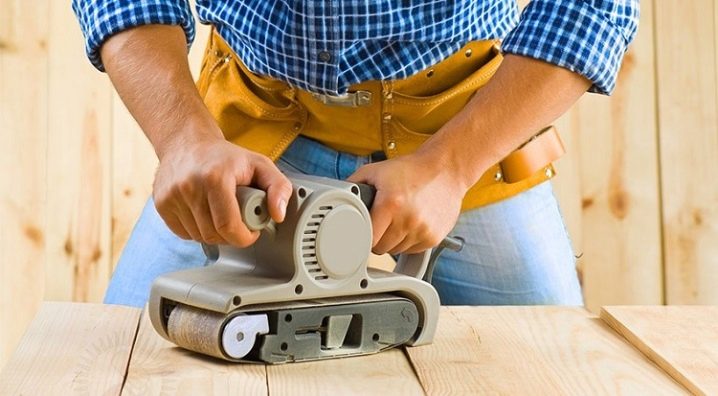
The belt sander, or LShM for short, is one of the most popular carpentry tools. The device is widely used both at the household and at the professional level, it is distinguished by its ease of use, processing efficiency and an acceptable price.
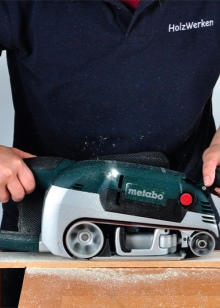


Features and Applications
The belt sander is an electromechanical tool that is used for sanding wood, concrete and metal substrates, while ensuring their absolute smoothness and uniformity. Using the device, you can effectively and quickly remove old paintwork from metal and wood, as well as to make rough processing of non-planed boards and beams. LShM is capable of processing areas of any area, as well as performing primary and intermediate grinding on them with the removal of a thick layer of wood.
What's more, belt models can perfectly prepare the work surface for fine sanding with eccentric or vibratory sanders. And also with the help of LShM it is possible to give roundness and other non-standard shapes to wooden blanks.

In addition, some models are equipped with clamps that allow you to fix the tool in an inverted position, that is, with the working surface up. This allows you to grind miniature parts, sharpen planes, knives and axes, as well as grind and refine the edges and edges of products. However, such work should be done with extreme care, moving in the direction of the belt abrasive and not touching it with your fingers. But also many machines are equipped with a bounding box that controls the grinding depth. This function is very convenient for beginners and does not allow to grind off thicker material.



Another important feature of the devices is their ability to grind and clean surfaces close to the wall. This is due to the peculiarity of the LShM design, which consists in flat sidewalls, the absence of protruding elements and the presence of additional rollers that allow processing dead zones. For the high efficiency of processing, which consists in the alternate removal of layers, and the ability to work in hard-to-reach places, tape machines are often compared to planers. However, unlike the latter, tape units require a minimum of labor, since they cope with the task much faster. This is due to the displaced downward center of gravity, which makes working with LBM easy, not requiring the application of great physical effort.

Principle of operation
All modifications of belt sanders have a similar design, which is why they work according to the same principle. The main driving force of the tool is an electric motor. It is he who creates the torque and transfers it to the roller mechanism, on which, in turn, the abrasive belt is looped. As a result of the rotation of the rollers, the belt also begins to move cyclically and grind the working surface.
Belt abrasives are available in a wide range of standard sizes, which allows you to quickly replace them and process the base with skins of different width and grain size.At the beginning of processing, a coarse-grained belt is installed, then during operation it is changed several times to fine-abrasive samples.
Typically, three to four numbers of sanding skins will result in a perfectly smooth surface.


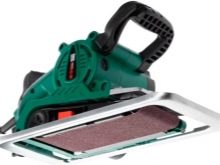
Views
The classification of belt sanders is made according to a number of characteristics. The main criterion is the scope of the models. According to this parameter, household and professional tools are distinguished. The former process mainly straight surfaces, while the latter are intended for the formation of complex arbitrary shapes and grinding curved and convex bases. Professional models are often equipped with a curved sole that can be pulled forward if necessary. In addition, the working life of the pro-units is much higher than that of inexpensive household appliances. Therefore, if regular use of the machine is expected, then it is preferable to choose a more functional device.
Among the professional models, there are highly specialized units designed for cleaning and grinding pipes., butt joints and any other rounded elements made of wood or metal. Such units differ from traditional models by the device of the tensioning mechanism and the absence of a sole. And one more type of professional equipment is represented by stationary machines. Such samples are characterized by increased power and are often equipped with a grinding disc.


As for the design features, stationary samples consist of the same units as manual specimens, and differ only in size and area of the working surface. Their advantage over mobile products is their special processing accuracy, high productivity and safety of use.
The next criterion for the classification of mechanisms is the tension of the sanding belt. On this basis, two types of devices are distinguished: with two and three rollers. The latter are equipped with a movable part with a third roller installed on it. Such a device allows the web to bend and capture a large area of the processed surface, thereby providing more accurate and high-quality grinding. The first do not have such advantages, being traditional household models designed for simple processing of flat surfaces.


Another sign of the classification of machines is the type of motor power supply. A distinction is made between electric, pneumatic and battery models. The former are completely volatile and require a 220 V power source in the immediate vicinity. The latter operate from an air compressor, are characterized by high power and performance, and can be used in the field. Battery-powered devices include pipe grinders with a battery capacity of more than 4 A. h and weighing about 3 kg.



Specifications
The defining operating parameters of belt sanders include their power, the speed of rotation and width of the abrasive, as well as the mass of the device.
- Power is one of the most important technical characteristics and directly affects a number of operational capabilities of the device. The power depends on the engine speed, energy consumption, weight of the unit and the time of its continuous operation. Modern machines have a power from 500 W to 1.7 kW. The lowest power is possessed by a mini-device Makita 9032, for its modest size it is called an electric file. The model is equipped with a very narrow belt and is able to work effectively in hard-to-reach places. Most household appliances are available with motors ranging from 0.8 to 1 kW, while for intensive work it is better to use 1.2 kW models. Professional stationary machines have a power of 1.7 kW or more and are characterized by high energy consumption.


- Rotational speed Abrasive belt is the second most important technical parameter, it depends entirely on the power of the engine, having a large impact on the speed of grinding and the overall quality of processing. In addition to power, the width of the belts themselves also affects the rotation speed. So, higher-speed units are designed for narrow abrasives, and wider specimens are installed on machines with low speed. The modern market presents LSHM with a speed of 75 to 2000 m / min, however, most household models operate at a speed of 300-500 m / min, which is the optimal value for use in home workshops. In a minute, such a unit is capable of removing from 12 to 15 g of a substance from the working surface, which favorably distinguishes LSHM from surface grinders and eccentric grinders, capable of removing from 1 to 5 g of a substance.
For work with small parts, as well as a tool for beginners, a device with a speed of 200 to 360 m / min is suitable. Such a machine will not remove more material than is required and will grind more slowly and evenly.
High-speed specimens with a speed of over 1000 m / min are intended for professional use and work in hard-to-reach places. Such models have a thinner abrasive belt and are capable of removing over 20 g of substance per minute.


- Machine weight is also an important factor affecting the usability of the unit and the quality of the sanding. Weight characteristics are especially important when performing vertical processing of doors, window frames and slopes, when the device has to be held for a long time. The mass of the unit directly depends on the engine power, and the more powerful the motor is installed on the LSHM, the heavier the product. So, medium-sized models for household use usually weigh in the range of 2.7-4 kg, while the weight of serious professional samples often reaches 7 kg. When working with heavy equipment, you must be extremely careful: when starting, the machine standing on a horizontal surface can suddenly jerk out of the hands and injure the operator. In this regard, the unit must first be started up, and only then put on a working base.
- Belt width is interrelated with the power of the motor and the rotation speed: the wider the width of the abrasive, the higher the power and the lower the speed, and vice versa. The most common tapes are 45.7 and 53.2 cm long and 7.7, 10 and 11.5 cm wide.The length multiplicity step is 0.5 cm.However, there are also models with non-standard lengths, which causes certain difficulties when choosing consumables materials.
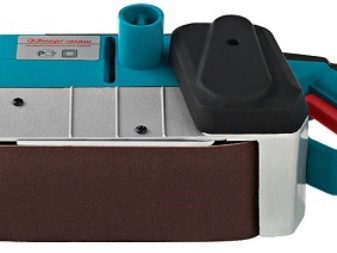

Rating of the best models
The modern market offers a huge number of different brands of LSHM models. Among them there are both expensive professional devices and very budget household samples. Below is an overview of the tools in several categories that are most interesting for the reader, after familiarizing yourself with which, it will become much easier to choose the right model.
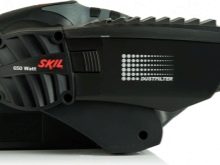


Inexpensive
The rating of economy class cars is headed by the BBS-801N model Chinese firm Bort, equipped with an 800 W electric motor. The device is designed for a tape measuring 76x457 mm and is capable of operating at a belt rotation speed of 260 m / min. The unit can be used in combination with a vacuum cleaner. It is also equipped with a speed governor. The model has a power button lock and is equipped with an electric cable 3 m long. The design features are the ability to quickly change the tape and the presence of a handle regulator. The basic package includes a dust collector, an abrasive belt and an additional handle. The weight of the device is 3.1 kg, the cost is 2,945 rubles. The warranty period is 60 months.
The second place in the rating of inexpensive devices belongs to the domestic model "Caliber LSHM-1000UE"with a 1 kW motor and a belt rotation speed of 120 to 360 m / min.The abrasive is well fixed on the roller mechanism, without slipping during grinding, and the unit itself is equipped with a handle with a lever that provides a comfortable grip, and two additional carbon brushes.


The width of the tape is 76 mm, the weight of the device is 3.6 kg. Consumers have no particular complaints about the tool, however, the need for periodic shutdowns arising due to overheating of the tape is noted. The cost of the product is 3,200 rubles.
And in third place is located MILITARY BS600 instrument with a power of 600 W and a belt rotation speed of 170-250 m / min. The device is designed for abrasive size 75x457 mm and is equipped with an electronic belt speed control function. The model has a built-in dust extraction system and two clamps to securely fix it in the desired position. The weight of the device is 3.2 kg, which allows it to be used for processing vertical surfaces. The model is distinguished by an ergonomic body and a convenient system for changing the abrasive belt, which is produced in a keyless way using a lever. During continuous operation, the start button can be locked. The cost of the model is 3 600 rubles.


For professionals
In this category of machines, the leader is Japanese Makita 9404 with abrasive size 10x61 cm. The model is equipped with a dust collector and a belt speed regulator. The motor power is 1.01 kW, the rotation speed is from 210 to 440 m / min. The car weighs 4.7 kg and costs 15,500 rubles. The second place is taken by a lightweight Swiss-made Bosch GBS 75 AE unit worth 16,648 rubles. The device is equipped with a cloth-based sanding belt, filter bag and graphite plate. Motor power is 410 W, belt speed - up to 330 m / min, product weight - 3 kg.
And in third place is a serious stationary combined tape-disk model Einhell TC-US 400... The unit is designed for small woodworking workshops and has a low noise level. The belt rotation speed reaches 276 m / min, the size is 10x91.5 cm. In addition to the belt abrasive, the device is equipped with a grinding disc with a rotation speed of 1450 rpm. The device weighs 12.9 kg and costs 11,000 rubles.



Reliability
According to this criterion, it is rather difficult to objectively evaluate the models. Each product has both strengths and weaknesses, so it is difficult to choose an unambiguous leader. Therefore, it would be fairer only to identify some models, positive reviews of which are most common. Such devices include Black Decker KA 88 worth 4,299 rubles. It offers an excellent price / performance ratio and, as a result of the reduced size of the front roller, is capable of efficient sanding in hard-to-reach areas.
The second place can be conditionally given to the unit Skil 1215 LA worth 4,300 rubles. Consumers position the device as a very reliable and durable device equipped, moreover, with automatic centering of the abrasive. The weight of the device is 2.9 kg, the speed is 300 m / min. The third place is taken by the domestic "Interskol LShM-100 / 1200E" worth 6 300 rubles. The model is equipped with a 1.2 kW motor, is capable of working with metal and stone, and also has a long service life in difficult conditions. The machine is capable of sharpening cutting tools, has a dust collector and weighs 5.6 kg.


Gadgets
In addition to the basic functions, many LSHM are equipped with different options and useful devices, facilitating the operation process and making the work with the device much more convenient.
- Smooth start of the tape. Thanks to this option, the abrasive begins to move not in a jerk, but progressively, thus eliminating injury to the operator.
- The additional handle allows for more precise grinding.
- The depth gauge will not allow you to remove extra millimeters beyond what was planned.
- Stationary fasteners make it possible to fix the machine on a hard surface, turning it into a grinding machine.
- The keyless abrasive change option allows you to change the belt with one move of the lever.
- The automatic centering function of the abrasive prevents the belt from sliding sideways during operation.


Which one to choose?
When choosing a LSHM, it is necessary to pay attention to such parameters as power, belt speed and unit weight. If the machine is planned to be used in a workshop, then it is better to purchase a desktop stationary model or a sample with the function of attachment to the table. This will eliminate the need to hold the device on weight and will allow you to handle small parts.
If it is planned to work with a professional model in the field or on the road, then the determining factor, along with the motor resource, should be weight. When buying a pipe processing device, it is better to choose a battery-powered model.
Such devices do not depend on electrical power sources, are lightweight and have a special belt tension loop designed for working with pipes.



Operating tips
When working with LSHM, it is necessary to follow some recommendations.
- For effective sanding of wood, the device's own weight is quite sufficient, so there is no need to put pressure on it during operation.
- You need to start sanding the wood with an abrasive with a grain size of 80, and finish - 120 units.
- The first movements when sanding wood should be performed at an angle to the direction of the wood grain. Next, you need to move along the structure of the tree, or make circular movements.
- The position of the electrical cord must be monitored. If it gets in the way, it is better to hang it on a bracket or throw it over your shoulder.
Always wear gloves and safety glasses when sanding any surface.

In the next video you will find an overview of the Interskol LShM-76/900 belt sander.













The comment was sent successfully.